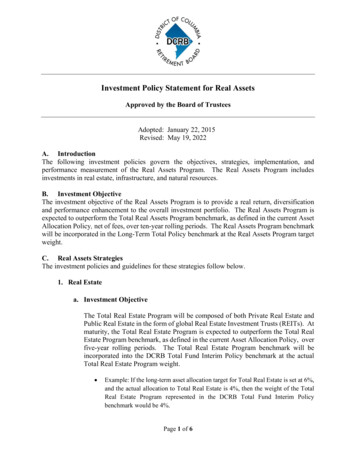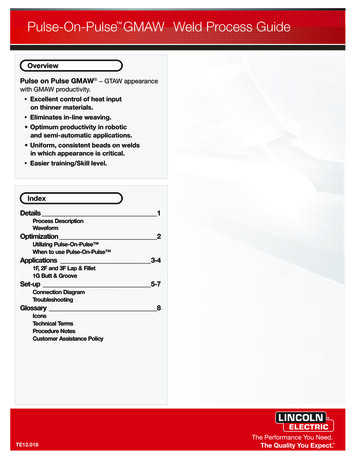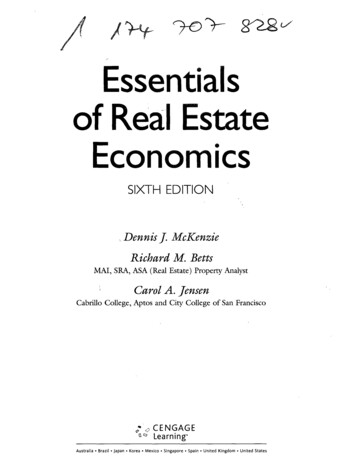
Transcription
IndustryPulseReport:RealEstateReport:RealReport: Real EstateEstate15 April 2020XX April 202001 May 2020
COVID-19 Industry Pulse Report: Real estate What is the industry sentiment around the impact of COVID-19on the Real estate sector? How is COVID-19 expected to impact the Real estate sector? What response measures have been taken to date to addressthe impact?
Stelios DemetriouPartnerTransaction Advisory Services LeaderReal estate and Hospitality LeaderForeword“The pandemic has caused globaleconomic turmoil and has disruptedconsumption and supply chains across theworld.Cyprus is once again facing an immensechallenge that is exacerbated by the globalinterconnectedness of its economy. Thesituation calls for ongoing monitoring toensure proper understanding and sounddecision-making.At EY Cyprus, we have prepared threeIndustry Pulse reports for the Banking, RealEstate and Hospitality sectors. The reportsaim to provide sector-specific perspectivewith regards to the impact of COVID-19, inconjunction with fiscal and monetary policyresponse, and include our own assessment oflikely scenarios and trends. In this report, wefocus on the Real Estate sector.3Our team has spoken with Real Estate sectorexecutives and leaders to obtain a realisticcollective sense of their sentiment andexpectations of this crisis, their views inrelation to the response measures to date andtheir insights with regards to recoveryscenarios and trends.This publication will be updated periodicallyand shall incorporate the most updatedpublicly available information in relation tothe impact of the virus on the aforementionedindustries, the government and regulators’response actions as well as an updatedeconomic assessment in accordance with ourview.We trust that this publication will become areference document for discussion amongstakeholders such as corporate executives,financial institutions and the government.Industry Pulse Report: Real estate
ContentsExecutiveSummaryPageOverview of theReal estatesector: Recentpast performanceCOVID-19 Keyfacts & figures5Page7PageHow COVID-19could disrupt theReal Estate lifecyclePage11Real estate sectorstakeholder mapand COVID-19ImpactPage14Overview of the Realestate sector:European Real EstateMarket sentiment PageIndustry Sentiment:EY Survey resultsPage1619Impact of COVID-19on the Real Estatesector: What do thescenarios mean forthe real estatemarket?Impact of COVID-19on the Real estatesector: Keyconsiderations andscenariosPage22Economic impact ofCOVID-19 on realestate : Sectorspecific governmentmeasuresPage4359PageReal estate marketpost-COVID:What can change forgood?Page36Industry Pulse Report: Real estate26How EY can helpPage37
Executive SummaryThe unprecedented impact of the COVID-19 crisis iscausing major operational disruptions in businesses aroundthe world and financial distress for households andindividuals, resulting in a global economic downturn. TheReal Estate (“RE”) sector has traditionally been a key pillarof the local economy and played a critical role in thecountry’s remarkable economic growth of recent years.Similarly, the sector is expected to be a key driver for theeconomic recovery from this current crisis. Due to theimportance of the sector, we have carried out a survey tocapture the market sentiment with regards to its potentialimpact from the COVID-19 crisis. The results of the survey,together with further analysis and research carried out,are presented in this Pulse Report.Industry Sentiment – Key TakeawaysAs part of the survey we approached key stakeholders of the sector and invited them to provide their views,expectations and sentiment in relation to the COVID-19 impact. The stakeholders considered included REdevelopers, construction companies, RE agents, lenders, RE appraisers and other advisors.Overview of EY survey key responses A sharp decline in transaction activity (c.70% based on some participants) already observed in the market The timely recommencement of construction activity and lifting of country lockdowns to facilitate viewings/salesare considered key for the recovery of transaction activity and mitigation of the adverse financial impact Participants are currently adapting their operations mode and using different measures to sustain business andstimulate sales activity (use of technology for remote sales/working from home, offer of discounts on askingprices, utilisation of employee support schemes introduced by the Government, etc) The majority of the participants feel that the immediate impact of the pandemic would be relatively short termand they will be in a position to recommence full operations shortly after the relaxation of measures. Recovery oftransaction activity however is expected to take longer and be gradual Different RE asset types are expected to be impacted in different ways and magnitudes by the pandemic. Retailproperties are expected to be the most affected, while residential assets the leastEuropean Real Estate Market sentiment The European market in general also faces reduced activity, with recorded sales showing in some cases y-o-yreductions of c.50% Transaction volumes are expected to suffer a much larger drop than property prices in the shorter term, with thelatter expected by analysts to fall on average by 8% in 2020 in the Eurozone. The COVID-19 uncertaintyadversely affects investor confidence and investment activity. Investment in the market from non-Europeaninvestors (representing around 50% of the total in the past) is further hindered by country lockdowns Factors that become important in this crisis include prime location, contracts with solid and long-term tenants, aswell as changing buyer/tenant preferences Changing trends: the COVID-19 crisis acted as a catalyst for the wider implementation of remote workingpractises and online shopping; which in effect adversely affect the office and retail RE markets respectivelyAdditional Sector Support measuresGovernment measures to support the sector are considered key in stimulating demand/investment and can beprovided in different forms. Tax incentives could take the form of elimination of CGT and transfer fees, reductionof VAT rates and tax payment deferrals. Construction activity can be supported through the elimination ofbureaucratic procedures (e.g. licensing). While overseas investment in the sector can be boosted through asupport and strengthening of the Cyprus Investment Programme.5Industry Pulse Report: Real estate
Executive Summary (cont’d)Scenarios examining the COVID-19 impact on the sectorSector performance is largely dependent on external factors such as the governments’ health-centric policies onsocial distancing and travel restrictions. Three relevant scenarios were tested by EY, reflecting different degrees ofsophistication/effectiveness of pandemic countermeasures. These are presented below.Scenario 2Scenario 1Partially effectiveeconomic responseassumption2020 Solid fiscal/monetarypolicies, robust economywide but partial sectorspecific measures, moderatetimeliness, modest EUsolidarity. Sector supply/capacitysuffers some contraction,mild depression. Severeresurgence episodenumber of RE sectorbankruptcies andunemployment Mid-Long-term demandrecovery Govt debt:Debt/GDP: AScenario 320202020 Virus Virusgenerally contained Limited RE sectorbankruptcies andunemployment Mid- term property demandrecovery Govt debt:Debt/GDP:well under controllimited RE sectorbankruptcies andunemployment Mid-short term propertydemand recovery Govt debt:Debt/GDP: VeryHighMediumLowSophistication/Effectiveness of pandemic countermeasuresDepth of red colour indicates magnitudeof COVID-19’s negative economic impactThe COVID-19 impact was considered under each scenario on the basis of two key metrics; sales revenue and thenumber of building permits issued. We then tested for each scenario the effect on individual property types, sincethese are affected differently by the pandemic. The graph on the left below presents a comparison of the effect ontotal RE sales for the three scenarios. On the right we also present a breakdown of Scenario 2 (chosen for indicativepurposes) for each different property type.Revenue breakdown by asset type forScenario 2Revenue from sales of real alLandCommercialTotal market20232024Key takeaways on COVID-19 impact from the scenario analysis— All three scenarios tested follow an initial large drop in revenue for 2020 resulting from the sharp drop in demandand transaction activity, recovering gradually (albeit at different rates). Scenario 3 is projected to recover quickerand is also the only scenario assumed to reach historic normalised levels post-COVID 19.— When considering each different asset type in isolation, residential and office units appear to be outperforming themarket, as opposed to other property types. It is noted that offices are presenting a decline in sales valuestowards the end of the period, reflecting the projected market trend towards flexible workspace and associatedreduction in space utilisation.— The asset type that appears to be affected most is retail, which since the commencement of the period presentsthe largest decline and remains well below the market total.6Industry Pulse Report: Real estate
COVID-19 Key facts & figuresIntroduction Present a snapshot of the latest facts, figures, discussions and the industry sentiment around COVID-19 Obtain the industry sentiment around the impact of COVID-19 on the Real Estate sector Estimate the potential impact of COVID-19 on the given sector Discuss effective fiscal and monetary measures for mitigating the adverse potential CyprusUKGreece death rate283746556473Days since first caseItalyGreeceKoreaCyprus death rateGermany death rateUK death rate8291Death rate (%)Cumulative Cases per 100k populationThe objective of the Industry Pulse report is to:0%100GermanyItaly death rateKorea death rateGovernments’ reactionHealthIn response to the rapid spread of the virus to date (depicted in the graph above) governments across the globehave adopted health-centric measures based on World Health Organisation’s guidance 1, with the aim to controlthe human-to-human transmission of the virus, and care for those affected. The measures focus on:— Support the healthcare system through investment in necessary equipment & staff, protecting healthworkers safety, ensuring critical care of non-virus-related incidents;— Enforcement of social distancing, closures of schools & public spaces, lockdowns, curfews, quarantines;— Control points of entry into country, through strict border or travel bans;— Contact tracing to identify cases, surveillance and monitoring of the spread; and— Testing ability, extending capacity of national and private laboratories for rapid and reliable tests.The introduction of these health measures has necessitated the consideration of unprecedented fiscal andmonetary interventions to limit the anticipated economic downturn2: Fiscal Monetary 1. onavirus-2019/technical-guidance2. cy-Responses-to-COVID-193. ackage7Industry Pulse Report: Real estateEconomy The European Commission has, for the first time ever, activated the general escape clause of theStability and Growth Pact to allow governments fiscal flexibility in budgetary rules.EU agreement on 540bln package of measures to support governments as they take onunprecedented debt burden: 100bln for joint employment insurance fund, 200bln for liquidity tocompanies through European Investment Bank instrument and 240bln for credit lines from EuropeanStability Mechanism3. Possibility of an additional temporary fund to help hardest-hit economies anddiscussion of option for joint sovereign debt issuance (corona bonds).Households: Income subsidisation and job guarantees, halt on evictions, tax breaks, VAT reductions,extension of loan obligations and suspension of instalments.Businesses: Salary payments to employees, suspension of financial obligations, favourable loan terms,tax breaks, deferral of VAT payments as well as sector-specific measures.ECB monetary support to governments such as additional asset purchases of 120bln until end-2020,an additional 750bln asset purchase program of private and public sector securities (PandemicEmergency Purchase Programme), removal of issuer limits from bond-buying programs to allowcentral banks to push borrowing costs down, relaxation of collateral standards for Eurosystemrefinancing operations.Banking package adopted to help facilitate lending to households and businesses. Temporaryrelaxation of Pillar 2 Guidance and liquidity coverage ratio, as well as flexibility in classificationrequirements and expectations on loss provisioning for non-performing loans that are covered bypublic guarantees.
COVID-19 Key facts & figuresWider implications of COVID-19 Decline in consumption Overleverage as debt to GDP ratio spirals Drop in investment Sustained burden on the healthcare system Structural changes as affected sectors shrink Long-term loss in productivity Spike in unemployment Poverty increase Potential banking crisis Increased digitalisationAccording to the latest worldwide research and discussions, expected timeframes for keymedical solutions are: Vaccination: 12-18 months Drugs/cure: 6 months (timing highly uncertain) Antigen (polymerase chain reaction “PCR”) tests that are cheap, mass-scalable and reliable :1-3 months Antibody (immunity) tests that are cheap, mass-scalable and reliable : 1-3 months8Industry Pulse Report: Real estateWider ImplicationsThe social and economic ramifications in the aftermath of the pandemic are expected to be severe andwidespread. These will likely include:
Overview of the Real Estate sectorRecent past performance (1/3)The Real Estate (‘RE’) sector constitutes one of the main pillars of the Cypriot economy and a key driver in thecountry’s remarkable economic turnaround following the 2013 financial crisis. Revenue generated from real estatesales, increased construction activity linked to these sales and sizeable foreign direct investments in the sector,contributed to this upwards trajectory.The following pages present the performance of the Cypriot Real Estate sector during recent years, focusing onrevenue generated from the sales of residential and non-residential units and also the volume of building permitsissued to capture the effect on construction activity.Real Estate sector revenuesThe performance of the sector in terms of sales revenue is shown in the graph below. The proceeds from the sale ofRE units (both residential and non) have been used as a proxy for the sector’s performance.The revenue generated from the sale of residential and non-residential units for2019 reached 5.7bln; representing an annual growth rate of c.26% since 2013. 1.3bln(2013) 5.7bln(2019)Revenue from sales of RE units ( ’bln)2013: RE sector negativelyaffected following thefinancial crisis and Marchbail-in; with a rapid fall indemand and propertyvalues. Provision offinancing for REacquisitions/developmentsalso becomes challengingdue to the banking sectordownsize and changes inlending procedures andcriteria.2015: Almost 3 years after theoutbreak of the financial turmoil, thesector exhibits continuous growth witha consecutive y-o-y increase. Thesector recaptures foreign investorinterest following government’s effortsto stimulate the market throughseveral incentive schemes (CIP*, taxreliefs, planning incentives, etc.). Signsof restoration of credibility andliquidity of the local banking industry,reflected in recapitalisation of thesector with participation of foreigninvestors.2018: Sales revenue reached a peak, with foreign buyersbeing one of the driving forces (almost half of thetransactions relating to new-built properties related toforeign buyers). Increasing investor appetite for upmarketproducts and larger exclusive projects, such as luxuriousapartments on high-rise beach-front developments, marinas,shopping malls, golf resorts, tourist developments, etc.6,114,152,351,931,3320132014201520162019: Sales revenuerecorded a y-o-y drop (c.7%), possibly indicatingrevenue stabilisationfollowing a clearance of thesales backlog createdfollowing the 2013 financialcrisis. Also change of CIPscheme in May, with theintroduction of increasedinvestment needs andstricter personal criteria.2017Source: LRO, EY Real Estate Data analytics platformNotes:*CIP: Cyprus Investment Programme. Citizenship by investment scheme introduced by Cypriot Government for naturalisation of foreign investors.95,675,61Industry Pulse Report: Real estate20187%31%18% osiaLarnaca
Overview of the Real estate sectorRecent past performance (2/3)Local vs ForeignerRE buyers (2019)c.47%18,8%Localsof new propertypurchasesForeignersSource: LRO , CyStat, EY Real EstateData analytics platform(2019)As noted, transactions carried out by foreign buyers have beenmaterial and their role has been significant in the recovery ofthe sector. Key in this respect have been the CIP* revisionsintroduced by the Government in 2013.The chart on the left presents the share of these purchases aspart of the total number of transactions (c.19%). It is importantto note that when it comes to new units the share of foreignersover total is even higher (c.47%). We also note that based on theexperience of recent years, transactions by foreigners tend tobe of much higher values than those carried out by locals (intheir majority laying around the 2m CIP investment threshold).These purchases also concern mostly high end residentialdevelopments in the coastal cities, and especially Limassol andPafos.The allocation between local and foreign buyers in terms of number of transactions for new built properties foreach district shown below. Despite the important role of foreign buyers, the local market remains the key driver inmost districts, especially Nicosia. The continuous growth of the local economy coupled with the recapitalisation ofthe local banking sector were key in supporting increasing activity from this market.Locals vs Foreigners in terms of new built properties 71,7%PaphosSource: LRO , CyStat, EY Real Estate Dataanalytics platformReal Estate prices Looking at the house price index issued by CyStat, a fluctuating pattern is observed since 2013; with consecutiveincreases in the index in more recent years and an apparent return closer to 2013 figures during the last quartersof 2019.House price index (2013-2019)104,4100,0100,82013 Q42014 Q4106,1101,9101,098,62015 Q42016 Q42017 Q42018 Q42019 Q4Source: CyStat, EY analysis, 2013 100The trend is to a certain extend attributed to the overall CIP performance of the last years, reflecting the CIPrevisions in 2013 and the boost of the program in the period leading to 2018. The CIP revisions introduced in2013 led to a significant number of high-end real estate transactions, with pricing at the upper end of range; thusdriving the overall index up. Following the last CIP revision in Q2 2019, with the introduction of increasedfinancial requirements and more strict personal criteria, the number of relevant transactions was reduced. This inturn exerted downwards pressure on the index.Notes:*CIP: Cyprus Investment Programme. Citizenship by investment scheme introduced by Cypriot Government for naturalisation of foreign investors.10Industry Pulse Report: Real estate
Overview of the Real estate sectorRecent past performance (3/3)Building PermitsThe growth of the RE sector, and the accompanied higher demand for new-built residential and other units, hasalso led to an increase in construction activity and the recovery of another sector of the economy badly hurt bythe 2013 financial crisis. This is reflected in the issuance of new building permits, which exhibited a steady growthboth in terms of numbers and total value in the period. The total number of permits issued during the period2013-2019 increased by a CAGR of c.5%. In monetary terms, the respective CAGR exceeded 20%. The relevanttrend is shown below:Number of Building permits issued5,3414,9335,0145,3545,7287,2186,408Building permits by type e ( 'm)IndustrialRetailOfficeOther (1)(1) Otherincludes the following types: Hotel and similarbuildings, Public entertainment buildings, Transport andcommunication building and Other non-residential buildings.Source: IMF, LRO, CyStat, EY Real Estate Data analytics platformThe great majority of the building permits issued concern residential properties, which in 2019 accounted formore than 80% of the total. The estimated total value of the building permits issued in 2019 for residentialbuildings stood at 2.4bln. This demonstrates the importance of the specific product type for the local economy.The specific type is also the one that has been attracting traditionally the majority of the foreign interest.In terms of districts, the largest cities of Nicosia and Limassol recorded the highest number of building permits;achieving consistently more than 60% of the total.Note: Part of the data employed in our analyses was obtained from the LRO portal on 24/01/2020. The data was further analysed by EY. We also note thatthese transactions exclude any share deals.11Industry Pulse Report: Real estate
How COVID-19 could disrupt the Real Estate lifecycle (1/2)Real estate is a sector that involves and affects a wide spectrum of stakeholders; both individuals and businesses.The diagram below presents the different stages of the RE lifecycle and some of the key stakeholders involved ineach stage. The text that follows expands on the different stages along with possible effects of the COVID-19outbreak on their duration and completion. The section closes with a separate analysis covering some of the keystakeholders and their ion nvestors/ Otherfinancial sponsorsDevelopmentSuppliers/Service providersFinancial sponsorsRElifecycleAgentsLocal authoritiesDisposalFinancial institutionsBuyersTenants / LandlordsOwnership/ManagementValuersProperty managementcompaniesLocal authoritiesKey# StakeholdersAcquisitionCOVID-19 impact: Physical viewing of assets by buyers interrupted/hindered due to lockdowns/movement restrictions. Sameapplies to real estate appraisers engaged to perform asset valuations for transaction purposes Relevant submissions to the LRO and other authorities interrupted/delayed (e.g. sales agreements, taxclearances, etc) Other due diligence activities also hindered by restrictions Face-to-face meetings/negotiations between transaction parties restricted General uncertainty surrounding COVID developments reducing investors’ appetite/willingness to finalise Securing new debt finance for transactions could be more challenging due to the COVID scenario/disruptionsEffect: Postponement/delay of acquisitions, resulting in limited transaction activityDevelopmentCOVID-19 impact: Disruption of construction activity due to Government decrees Disruption of supply chain relating to construction materials (both logistics and actual production) Delays in securing planning/building permits due to limited access to relevant authorities Design process partly disrupted due to site visit restrictions Obtaining new financing for development purposes more challengingEffect: Delays in the completion of construction/handover of units under construction, with possibility of damages incase force majeure provisions do not apply New projects in the pipeline put on hold Possibility of higher construction/development costs due to delays/disruption of activities Necessity for cost cutting/control activities of relevant stakeholders in order to address reduced revenues/cashliquidity pressure12Industry Pulse Report: Real estate
How COVID-19 could disrupt the Real Estate lifecycle (2/2)ValuersLocalauthoritiesConstruction nvestors/ Otherfinancial sponsorsDevelopmentSuppliers/Service providersFinancial sponsorsRElifecycleAgentsLocal authoritiesDisposalFinancial institutionsBuyersTenants / LandlordsOwnership/ManagementValuersProperty managementcompaniesLocal authoritiesKey# StakeholdersOwnership/ ManagementCOVID-19 impact: Tenants face liquidity pressure, preventing them from meeting payments and other contractual obligations Liquidity pressure on owners, preventing them from serving financing obligations or carrying out planned/agreed capital expenditure (refurbishments, etc) Curfews/movement restrictions reduce the possibility of securing tenants for vacant properties. New tenantsalso discouraged to enter into transactions due to COVID consequences/uncertainty Property management activities (maintenance, etc) disrupted/delayed due to movement restrictionsEffect: New/existing tenants attempt to renegotiate key contractual terms (rent-free periods, lease durations, leaseamounts, etc) Cost cutting/control activities of relevant stakeholders to address reduced revenues/ liquidity pressureDisposalCOVID-19 impact: Disposal efforts hindered by COVID related restrictions, as presented under ‘Acquisition’ box (viewings, duediligence, valuations, submissions, etc). Especially in case of CIP applicants and other foreign buyers/investors Reduced demand due to COVID related uncertainty/lack of funds Opportunistic buyers may seek to take advantage of the crisis and transact at reduced prices Disposal efforts may be put on hold by some vendors in an effort to protect sales valueEffect: Reduced number of transactions due to limited demand and transaction closing issues Potential buyers may demand additional discounts to compete transactions. Property valuations distorted bythe COVID scenario, exerting further downward pressure on prices Vendors not compelled to sell likely to resist such pressures, increasing bid-ask spread and reducing transactionvolumes further Cost cutting/control activities of relevant stakeholders to address reduced revenues/ liquidity pressure Vendors/agents adapting their sales and marketing efforts to accommodate the COVID scenario (new and moreinnovative promotion methods, etc)13Industry Pulse Report: Real estate
Real estate sector key stakeholder map and COVID-19impact (1/2)Below we illustrate how some of the key stakeholders in the RE ecosystem could be affected by the COVID-19outbreak. We also present potential reactions of these players in their effort to respond and adapt to the newsituation imposed by the pandemic. The parties expected to be affected most are presented first.Developers & RelatedDeveloping CompaniesWorkforceCOVID-19 impact: Significant reduction in revenues, especially in relation toforeign buyers Delays in handover of off-plan sales due to constructiondisruptions Higher costs associated with construction disruptions andother categories (Health & Safety, marketing, etc) Cash liquidity pressure as revenues fallCOVID-19 impact: Impacted by potential salary reductions, redundanciesand halt on recruitments Liquidity pressure Increased health and safety concerns of workforce,especially in case of customer facing staff Job insecurity Difficulties in carrying out normal duties in case ofdependant at homeReaction: Reduction of asking prices and hence profit margins tostimulate demand Cost saving/control exercises (staff costs, admin costs,marketing and promotion, etc) Delay in the launch of new projectsReaction: Consideration of alternative income sources Utilisation of Government support schemes Reduced spendingContractorsSuppliersCOVID-19 impact: Suspension/Disruption of operations due to Governmentdecrees Reduction in revenues from new contracts as projects areput on halt by developers and other clients Increased Health & Safety requirements and costs Supply chain disruptions with regards to building materials Delays in the handover of projects, resulting in increasedcosts Potential loss of skilled labour Cash liquidity pressureCOVID-19 impact: Reduced revenues due to suspension of large-scaleconstruction activity and delay of new projects Supply chain disruptions due to lockdowns and otherrestrictions (transportation/production issues, etc.) Liquidity pressureReaction: Cost savings, including payroll reductions Adjustment of working capital managementReaction: Cost saving/control exercises (staff costs, etc) Bidding for projects at low margins to cover fixed costs Focus on working capital management14Industry Pulse Report: Real estate
Real estate sector key stakeholder map and COVID-19impact (2/2)GovernmentCOVID-19 impact: Suspension/decrease in RE activity leads to reduced Government inflows in the form of taxation and other fees and charges(e.g. direct/ indirect tax, CIP related charges, etc) Pressure on Government to support the economy and social welfare Liquidity pressured as a result of the reduced inflows and huge spending on support mechanismsReaction: Measures to support the local economy; including employment support schemes, deferral of tax receipts and reduction oftax rates such as VAT, etc. Increased borrowing in order to meet the costTenants/BuyersCOVID-19 impact: Potential loss of income as a result of COVID crisis impacting the ability to meet lease obligations/purchase the RE products Insecurity with regards to new transactions due to the COVID related uncertaint
Real Estate lifecycle Page 11 Industry Sentiment: EY Survey results Page 16 Impact of COVID-19 on the Real estate sector: Key considerations and scenarios Page 22 Overview of the Real estate sector: European Real Estate Market sentiment Page 19 Real estate sector stakeholder map and COVID-19 Impact Page 14 Impact of COVID-19 on the Real Estate










